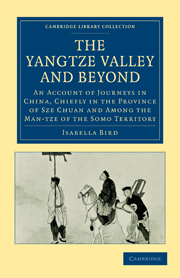 The Yangtze Valley and Beyond
The Yangtze Valley and Beyond Book contents
- Frontmatter
- PREFACE
- Contents
- LIST OF ILLUSTRATIONS
- ERRATA
- CHAPTER I GEOGRAPHICAL AND INTRODUCTORY
- CHAPTER II “THE MODEL SETTLEMENT”
- CHAPTER III HANGCHOW
- CHAPTER IV THE HANGCHOW MEDICAL MISSION HOSPITALS
- CHAPTER V SHANGHAI TO HANKOW (HANKAU)
- CHAPTER VI THE FOREIGNERS—HANKOW AND BRITISH TRADE
- CHAPTER VII CHINESE HANKOW (HANKAU)
- CHAPTER VIII HANKOW TO ICHANG
- CHAPTER IX ICHANG
- CHAPTER X THE UPPER YANGTZE
- CHAPTER XI RAPIDS OF THE UPPER YANGTZE
- CHAPTER XII RAPIDS AND TRACKERS
- CHAPTER XIII LIFE ON THE UPPER YANGTZE
- CHAPTER XIV THE YANGTZE AND KUEI FU
- CHAPTER XV NEW YEAR'S DAY AT KUEI-CHOW FU
- CHAPTER XVI KUEI FU TO WAN HSIEN
- CHAPTER XVII CHINESE CHARITIES
- CHAPTER XVIII FROM WAN HSIEN TO SAN TSAN-PU
- CHAPTER XIX SZE CHUAN TRAVELLING
- CHAPTER XX SAN-TSAN-PU TO LIANG-SHAN HSIEN
- CHAPTER XXI LIANG-SHAN HSIEN TO HSIA-SHAN-PO
- CHAPTER XXII HSIA-SHAN-PO TO SIAO-KIAO
- CHAPTER XXIII SIAO-KIAO TO HSIEH-TIEN-TZE
- CHAPTER XXIV HSIEH-TIEN-TZE TO PAONING FU
- CHAPTER XXV PAONING FU AND SIN-TIEN-TZE
- CHAPTER XXVI SIN-TIEN-TZE TO TZE-TUNG HSIEN
- CHAPTER XXVII TZE-TUNG HSIEN TO KUAN HSIEN
- CHAPTER XXVIII KUAN HSIEN AND CHENGTU
- CHAPTER XXIX KUAN HSIEN TO SIN-WEN-PING
- CHAPTER XXX SIN-WEN-PING TO LI-FAN TING
- CHAPTER XXXI LI-FAN TING TO TSA-KU-LAO
- CHAPTER XXXII THE “BEYOND”
- CHAPTER XXXIII THE MAN-TZE, I-REN, OR SHAN-SHANG-REN
- CHAPTER XXXIV FROM SOMO TO CHENGTU FU
- CHAPTER XXXV DOWNWARD BOUND
- CHAPTER XXXVI LUCHOW TO CHUNG-KING FU
- CHAPTER XXXVII THE JOURNEY'S END
- CHAPTER XXXVIII THE OPIUM POPPY AND ITS USE
- CHAPTER XXXIX NOTES ON PROTESTANT MISSIONS IN CHINA
- CONCLUDING REMARKS
- ITINERARY
- APPENDICES
- INDEX
- Plate section
CHAPTER VI - THE FOREIGNERS—HANKOW AND BRITISH TRADE
Published online by Cambridge University Press: 05 July 2011
- Frontmatter
- PREFACE
- Contents
- LIST OF ILLUSTRATIONS
- ERRATA
- CHAPTER I GEOGRAPHICAL AND INTRODUCTORY
- CHAPTER II “THE MODEL SETTLEMENT”
- CHAPTER III HANGCHOW
- CHAPTER IV THE HANGCHOW MEDICAL MISSION HOSPITALS
- CHAPTER V SHANGHAI TO HANKOW (HANKAU)
- CHAPTER VI THE FOREIGNERS—HANKOW AND BRITISH TRADE
- CHAPTER VII CHINESE HANKOW (HANKAU)
- CHAPTER VIII HANKOW TO ICHANG
- CHAPTER IX ICHANG
- CHAPTER X THE UPPER YANGTZE
- CHAPTER XI RAPIDS OF THE UPPER YANGTZE
- CHAPTER XII RAPIDS AND TRACKERS
- CHAPTER XIII LIFE ON THE UPPER YANGTZE
- CHAPTER XIV THE YANGTZE AND KUEI FU
- CHAPTER XV NEW YEAR'S DAY AT KUEI-CHOW FU
- CHAPTER XVI KUEI FU TO WAN HSIEN
- CHAPTER XVII CHINESE CHARITIES
- CHAPTER XVIII FROM WAN HSIEN TO SAN TSAN-PU
- CHAPTER XIX SZE CHUAN TRAVELLING
- CHAPTER XX SAN-TSAN-PU TO LIANG-SHAN HSIEN
- CHAPTER XXI LIANG-SHAN HSIEN TO HSIA-SHAN-PO
- CHAPTER XXII HSIA-SHAN-PO TO SIAO-KIAO
- CHAPTER XXIII SIAO-KIAO TO HSIEH-TIEN-TZE
- CHAPTER XXIV HSIEH-TIEN-TZE TO PAONING FU
- CHAPTER XXV PAONING FU AND SIN-TIEN-TZE
- CHAPTER XXVI SIN-TIEN-TZE TO TZE-TUNG HSIEN
- CHAPTER XXVII TZE-TUNG HSIEN TO KUAN HSIEN
- CHAPTER XXVIII KUAN HSIEN AND CHENGTU
- CHAPTER XXIX KUAN HSIEN TO SIN-WEN-PING
- CHAPTER XXX SIN-WEN-PING TO LI-FAN TING
- CHAPTER XXXI LI-FAN TING TO TSA-KU-LAO
- CHAPTER XXXII THE “BEYOND”
- CHAPTER XXXIII THE MAN-TZE, I-REN, OR SHAN-SHANG-REN
- CHAPTER XXXIV FROM SOMO TO CHENGTU FU
- CHAPTER XXXV DOWNWARD BOUND
- CHAPTER XXXVI LUCHOW TO CHUNG-KING FU
- CHAPTER XXXVII THE JOURNEY'S END
- CHAPTER XXXVIII THE OPIUM POPPY AND ITS USE
- CHAPTER XXXIX NOTES ON PROTESTANT MISSIONS IN CHINA
- CONCLUDING REMARKS
- ITINERARY
- APPENDICES
- INDEX
- Plate section
Summary
Hankow or Hanmouth, Wu-Chang Fu, the capital of Hupeh, and Han Yang would be one city were they not bisected by the broad, rolling Yangtze, nearly a mile wide, and its great tributary the Han. Hankow and Han Yang are on the north bank, and Wu-Chang on the south. The “congeries of cities,” as the three have been aptly termed, is about 600 miles from Shanghai. Till 1863 Hankow was an open city, but the dread of an attack by northern banditti that year led the Government to enclose it with a stone wall, four miles in circuit and thirteen feet in height, raised by a brick parapet to eighteen feet.
Hankow considers that it has the finest bund in China, and I have no wish to dispute its assertion. In truth its length of 800 yards, its breadth of 80, its lofty and noble river wall and fine flights of stone stairs, ascending 40 feet from low water, its broad promenade and carriage-way and avenue of fine trees, with the “palatial” houses, very similar to those of Shanghai and Singapore, on the other side in large gardens and shaded by exotic trees, make it scarcely credible that the first authentic visit of Europeans to the city was that made by Lord Elgin in H.M.S. Furious in 1858, and that the site for this stately British settlement was only chosen in 1861, the year in which the port was opened to foreign trade.
- Type
- Chapter
- Information
- The Yangtze Valley and BeyondAn Account of Journeys in China, Chiefly in the Province of Sze Chuan and Among the Man-tze of the Somo Territory, pp. 61 - 66Publisher: Cambridge University PressPrint publication year: 2010First published in: 1899


